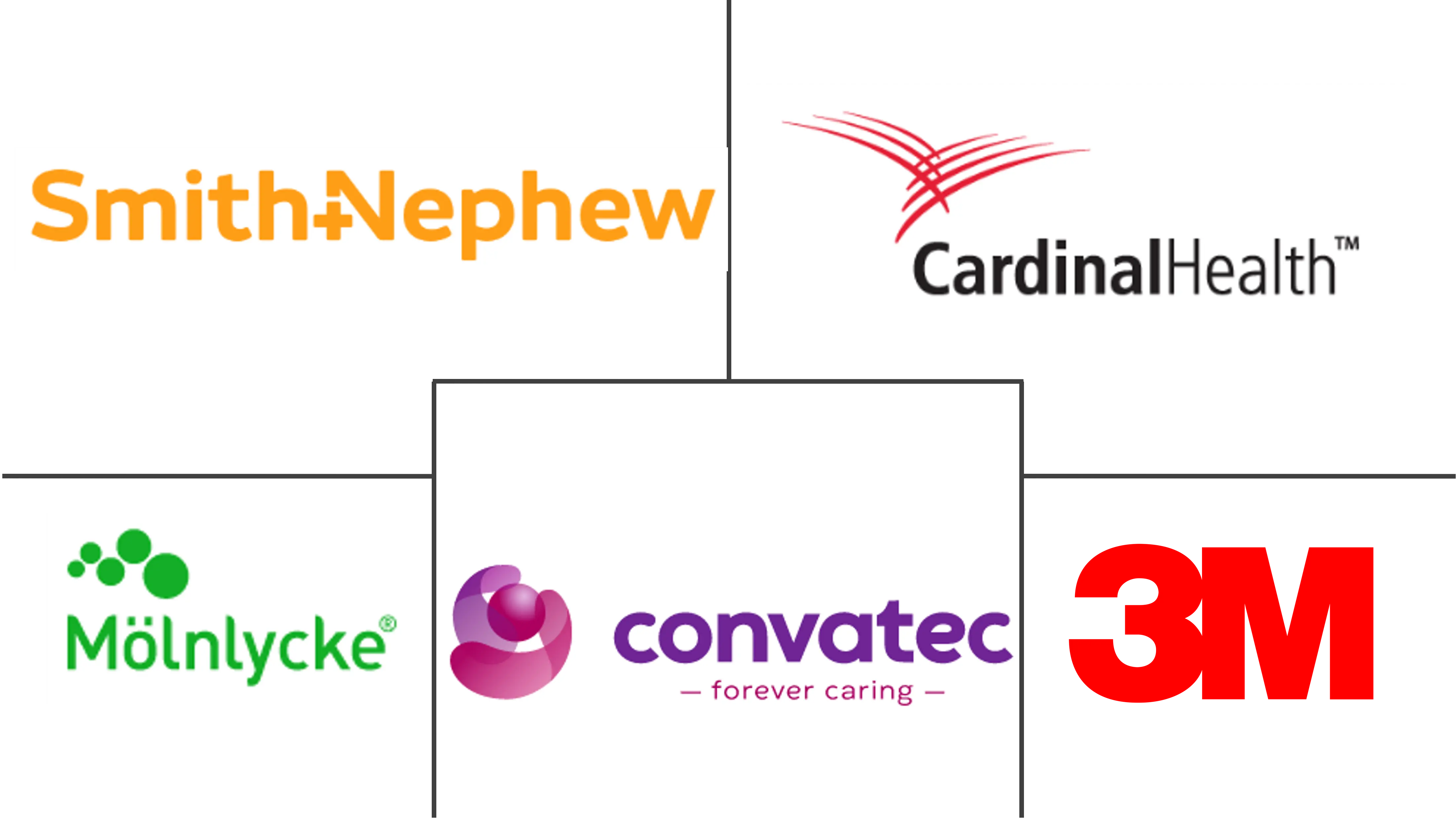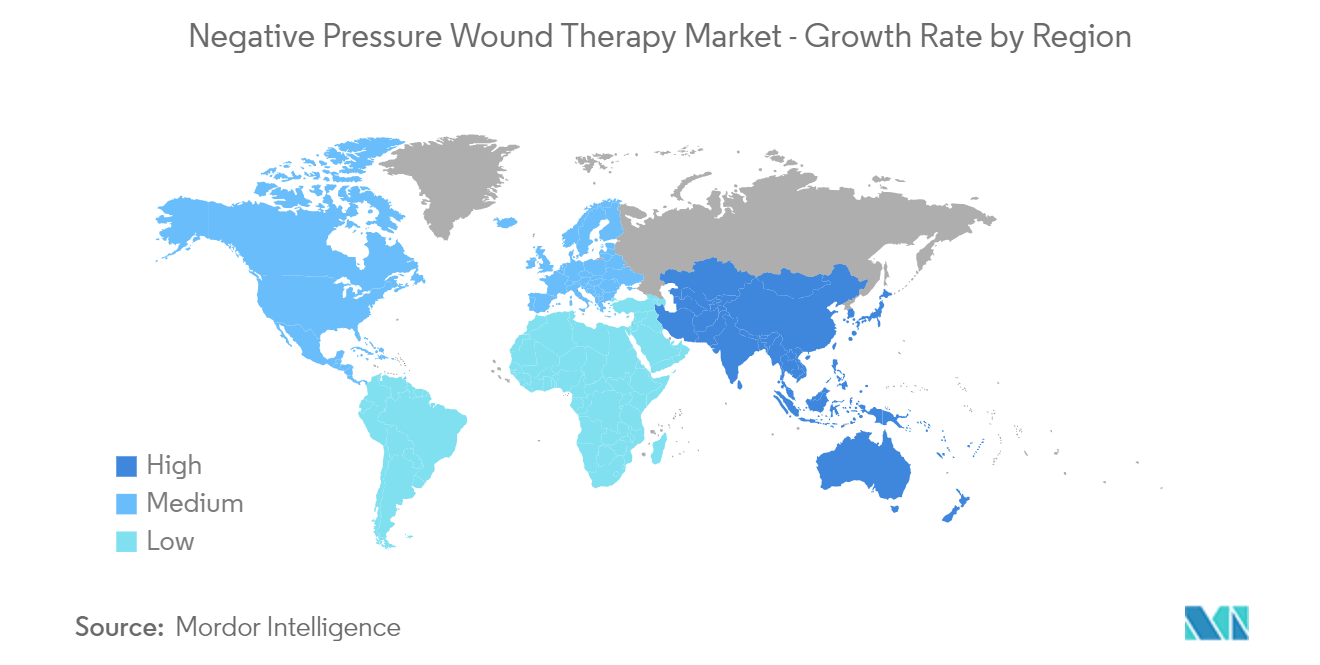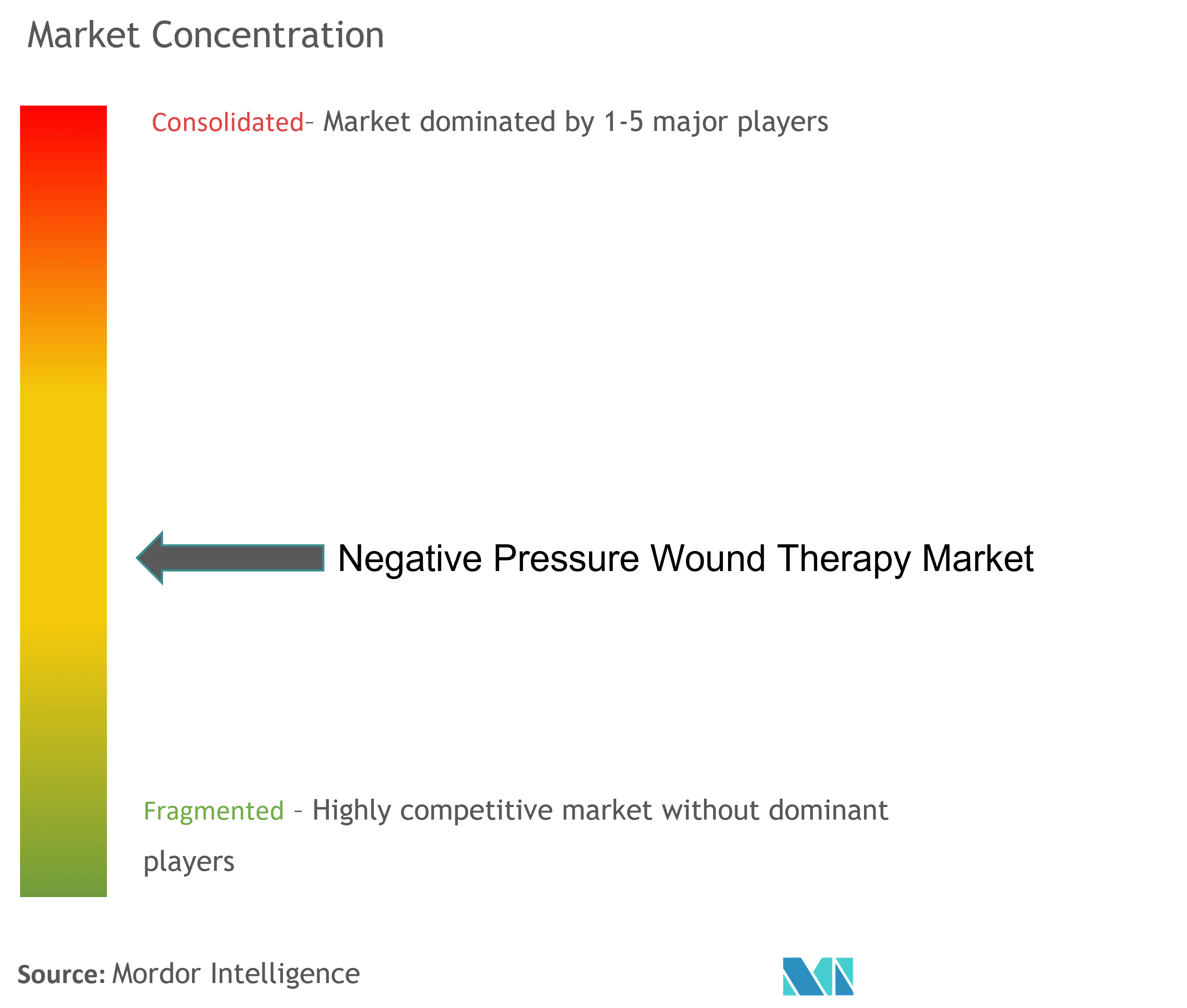Negative Pressure Wound Therapy Market Size

| Study Period | 2019 - 2029 |
| Market Size (2024) | USD 2.9 Billion |
| Market Size (2029) | USD 3.70 Billion |
| CAGR (2024 - 2029) | 5.46 % |
| Fastest Growing Market | Asia Pacific |
| Largest Market | North America |
| Market Concentration | Medium |
Major Players
*Disclaimer: Major Players sorted in no particular order |
Negative Pressure Wound Therapy Market Analysis
The Negative Pressure Wound Therapy Market size is estimated at USD 2.9 billion in 2024, and is expected to reach USD 3.70 billion by 2029, growing at a CAGR of 5.46% during the forecast period (2024-2029).
The COVID-19 pandemic had a significant impact on the growth of the market. With the nationwide lockdowns, the number of people getting on the roads declined, and there was a drastic decrease in the number of accidents and injuries. For instance, as per the article published by Wound Repair and Regeneration in October 2021, levels 2-5 evidence revealed a paradigm shift in wound care toward hybrid telemedicine and home healthcare models to keep patients at home to minimize the number of in-person visits at clinics and hospitalizations, except in severe cases such as chronic limb-threatening ischemia. Hence, all the factors mentioned above showed that COVID-19 had a notable impact on the Negative Pressure Wound Therapy Market Trends. However, as the pandemic has currently subsided, the market is expected to experience pre-pandemic levels of growth during the forecast period of the study.
Negative Pressure Wound Therapy (NPWT) is the most preferred choice of treatment, especially for deep acute wounds and persistent chronic wounds, including leg ulcers. Some of the factors that are driving the overall market growth are the increasing number of accidents and traumatic events, rising chronic wounds such as diabetic foot ulcers, and technological advancements in Negative Pressure Wound Therapy Devices.
Chronic wounds lead to complications such as infection, ulceration, and insufficient blood supply, thus prolonging the Wound Healing period. The most common chronic wounds include venous ulcers, diabetic foot ulcers, and pressure ulcers. As per the 2022 update from the International Diabetic Federation (IDF), approximately 537 million adults (20-79 years) were living with diabetes in 2021. The total number of people living with diabetes is projected to rise to 643 million by 2030 and 783 million by 2045. Moreover, as per the IDF 2021 report, diabetic foot ulcers affect 40 to 60 million people globally. As a result, the market is likely to grow due to the increased prevalence of diabetic foot ulcers. Also, the localized use of Negative Pressure Wound Treatment in infected wounds offers advantages such as wound drainage, angiogenesis stimulation, proteinase excretion, and decreased local and systemic bacterial load.
Moreover, the study published by Sage Journals in August 2021 reported that venous leg ulcers (VLU) account for 70% of all chronic leg ulcers and are associated with a recurrence rate of 60-70% at 10 years. The deep venous ulcers are responsible for 90% of the venous return to the right atrium from the lower extremities. Such a recurrence of the condition creates the need for NPWT devices and is thus expected to drive the growth of the NPWT Devices Market.
Additionally, the developments by various Negative Pressure Wound Therapy Companies are also expected to boost the market growth. For instance, in March 2022, Cork Medical entered into a partnership with MedTech Solutions Group (MTSG). As per the agreement, MTSG will manage Cork Medical's international Negative Pressure Wound Therapy (NPWT) business in all countries except the United States. Such strategic initiatives are expected to boost the growth of the market.
Thus, due to the above-mentioned factors such as the high prevalence of chronic wounds and the developments by market players, the Negative Pressure Wound Therapy Market is expected to grow at a significant rate during the forecast period. However, the high cost of devices and treatment can restrain the market's growth.
Negative Pressure Wound Therapy Market Trends
Diabetic Foot Ulcers Segment is Expected to Have a Significant Market Share During the Forecast Period
A diabetic foot ulcer is an open sore or wound that occurs in patients with diabetes and is commonly located on the bottom of the foot. The use of Vacuum Assisted Closure (NPWT) was found to be effective in achieving faster wound bed granulation in diabetic foot ulcers. Due to the increased application of NPWT in diabetic foot ulcers, this segment of the Negative Pressure Wound Therapy Market is expected to project significant growth over the forecast period.
Moreover, according to the International Diabetes Federation Diabetes Atlas, February 2022 report, an estimated 61 million adults (20-79 years) were living with diabetes in the Europe Region in 2021. The number of adults with diabetes is predicted to rise to 69 million by 2045, an increase of 13%. The surge in the prevalence of diabetes among all ages in the European Region is likely to increase the cases of diabetic foot ulcers, which will ultimately augment the segment's growth. Due to the increasing number of people with diabetic foot ulcers globally, there is a growing demand for Negative Pressure Wound Therapy Devices, as it is one of the most efficacious, safe, and cost-effective methods of treating diabetic foot ulcers.
Additionally, the growing number of studies demonstrating the importance of NPWT is also expected to propel the growth of the segment. For instance, an article published by Burns & Trauma in June 2021 concluded that the treatment of diabetic foot requires a cross-disciplinary and systematic approach, within which NPWT, as an Advanced Wound Therapy, is an important adjunct treatment for diabetic foot wounds. It also reported that the standardised management and application of NPWT may improve wound exudate drainage, enhance blood perfusion, and promote wound healing.
Hence, due to the efficacy of Negative Pressure Wound Therapy in healing diabetic foot ulcers in less time, the demand for Negative Pressure Wound Therapy is increasing. Adding to that, the rising incidence and prevalence of diabetic foot ulcers across the globe also fuel the segment's growth in the Wound Therapy Devices Market. Thus, the market segment is expected to show significant growth over the forecast period.

North America is Expected to Hold a Significant Share in the Market Over the Forecast Period
The North America Negative Pressure Wound Therapy Market is expected to grow significantly due to the rising prevalence of chronic wounds and the increased number of accidents in this region. The United States Negative Pressure Wound Therapy Market, being part of one of the most developed economies and technologically advanced countries, holds a notable share of the studied market.
The high burden of diabetes in the region is also expected to drive the growth of the market. For instance, according to the International Diabetes Federation, in 2021, there were 32.2 million prevalent cases of diabetes (20-79 years old) in North America, and this is expected to reach 36.8 million by 2045. Such an increasing burden of diabetes raises the risk of diabetic foot ulcer and is thus expected to drive the growth of the Negative Pressure Wound Therapy Market in the region.
Additionally, the strategic initiatives taken by the market players are expected to drive the growth of the market in the region. For instance, in April 2021, Joerns Healthcare signed a distribution agreement with Medela to distribute Medela's Negative Pressure Wound Therapy (NPWT) product line on a national basis to skilled nursing and long-term acute care hospital settings. Also, the market players are focusing on user experience to gain a competitive edge.
Thus, owing to the abovementioned factors, such as the rising prevalence of chronic wounds and the strategic initiatives by market players, the North America Negative Pressure Wound Therapy Market is expected to show significant growth over the forecast period.

Negative Pressure Wound Therapy Industry Overview
The market for Negative Pressure Wound Therapy is moderately competitive with the presence of most international companies. In terms of Negative Pressure Wound Therapy Market Share, a few of the major players are currently dominating the market. Some of the companies which are currently dominating the market are 3M, Smith & Nephew, Molnlycke Health Care AB, Covatec Inc., Cardinal Health, and others.
Negative Pressure Wound Therapy Market Leaders
-
ConvaTec Inc.
-
Cardinal Health, Inc.
-
Smith & Nephew plc
-
3M
-
Mölnlycke Health Care AB
*Disclaimer: Major Players sorted in no particular order

Negative Pressure Wound Therapy Market News
- May 2023: Smith+Nephew announced its PICO Single Use Negative Pressure Wound Therapy Systems have received an Innovative Technology contract from Vizient, Inc. The contract was awarded based on the PICO Single Use Negative Pressure Wound Therapy Systems recommendation by hospital experts who serve on one of Vizient's member-led councils.
- January 2022: Smith & Nephew announced a new indication for use for its PICO 7 and PICO 14 single-use negative pressure wound therapy systems. The United States Food and Drug Administration (FDA) cleared the systems for use on closed surgical incisions to reduce the incidence of wounds.
Negative Pressure Wound Therapy Market Report - Table of Contents
1. INTRODUCTION
1.1 Study Assumptions and Market Definition
1.2 Scope of the Study
2. RESEARCH METHODOLOGY
3. EXECUTIVE SUMMARY
4. MARKET DYNAMICS
4.1 Market Overview
4.2 Market Drivers
4.2.1 Increasing Number of Accidents and Traumatic Events
4.2.2 Rising Incidence of Chronic Wounds Such as Diabetic Foot
4.2.3 Technological Advancements in the NPWT Devices
4.3 Market Restraints
4.3.1 High Cost of Device and Treatment
4.3.2 Complications Associated With NPWT Device
4.4 Porter's Five Force Analysis
4.4.1 Bargaining Power of Suppliers
4.4.2 Bargaining Power of Buyers/Consumers
4.4.3 Threat of New Entrants
4.4.4 Threat of Substitute Products
4.4.5 Intensity of Competitive Rivalry
5. MARKET SEGMENTATION (Market Size by Value - USD)
5.1 By Product
5.1.1 Reusable Device
5.1.2 Single-use Device
5.2 By Wound Type
5.2.1 Diabetic Foot Ulcer
5.2.2 Pressure Ulcer
5.2.3 Venous Leg Ulcer
5.2.4 Burn Wounds
5.2.5 Other Wound Types
5.3 By End User
5.3.1 Hospitals
5.3.2 Homecare
5.3.3 Other End Users
5.4 Geography
5.4.1 North America
5.4.1.1 United States
5.4.1.2 Canada
5.4.1.3 Mexico
5.4.2 Europe
5.4.2.1 Germany
5.4.2.2 United Kingdom
5.4.2.3 France
5.4.2.4 Italy
5.4.2.5 Spain
5.4.2.6 Rest of Europe
5.4.3 Asia-Pacific
5.4.3.1 China
5.4.3.2 Japan
5.4.3.3 India
5.4.3.4 Australia
5.4.3.5 South Korea
5.4.3.6 Rest of Asia-Pacific
5.4.4 Middle East and Africa
5.4.4.1 GCC
5.4.4.2 South Africa
5.4.4.3 Rest of Middle East and Africa
5.4.5 South America
5.4.5.1 Brazil
5.4.5.2 Argentina
5.4.5.3 Rest of South America
6. COMPETITIVE LANDSCAPE
6.1 Company Profiles
6.1.1 3M
6.1.2 Talley Group Ltd
6.1.3 Smith & Nephew
6.1.4 Otivio (FlowOx)
6.1.5 Molnlycke Health Care AB
6.1.6 Medela AG
6.1.7 DeRoyal Industries Inc.
6.1.8 ConvaTec Inc.
6.1.9 Cardinal Health
6.1.10 Paul Hartmann AG
- *List Not Exhaustive
7. MARKET OPPORTUNITIES AND FUTURE TRENDS
Negative Pressure Wound Therapy Industry Segmentation
As per the scope of the report, negative-pressure wound therapy (NPWT) is a therapeutic technique that uses a suction dressing to remove excess exudate and promote healing in acute or chronic wounds and second and third-degree burns. The Negative Pressure Wound Therapy Market is segmented by Product (Reusable Device and Single-use Device), Wound Type (Diabetic Foot Ulcer, Pressure Ulcer, Venous Leg Ulcer, Burn Wounds, and Others), End-user (Hospitals, Homecare, Other End Users), and Geography (North America, Europe, Asia-Pacific, Middle East and Africa, and South America). The market report also covers the estimated market sizes and trends for 17 different countries across major regions globally. The report offers the value (in USD) for the above segments.
| By Product | |
| Reusable Device | |
| Single-use Device |
| By Wound Type | |
| Diabetic Foot Ulcer | |
| Pressure Ulcer | |
| Venous Leg Ulcer | |
| Burn Wounds | |
| Other Wound Types |
| By End User | |
| Hospitals | |
| Homecare | |
| Other End Users |
| Geography | ||||||||
| ||||||||
| ||||||||
| ||||||||
| ||||||||
|
Negative Pressure Wound Therapy Market Research FAQs
How big is the Negative Pressure Wound Therapy Market?
The Negative Pressure Wound Therapy Market size is expected to reach USD 2.9 billion in 2024 and grow at a CAGR of 5.46% to reach USD 3.70 billion by 2029.
What is the current Negative Pressure Wound Therapy Market size?
In 2024, the Negative Pressure Wound Therapy Market size is expected to reach USD 2.9 billion.
Who are the key players in Negative Pressure Wound Therapy Market?
ConvaTec Inc., Cardinal Health, Inc., Smith & Nephew plc, 3M and Mölnlycke Health Care AB are the major companies operating in the Negative Pressure Wound Therapy Market.
Which is the fastest growing region in Negative Pressure Wound Therapy Market?
Asia Pacific is estimated to grow at the highest CAGR over the forecast period (2024-2029).
Which region has the biggest share in Negative Pressure Wound Therapy Market?
In 2024, the North America accounts for the largest market share in Negative Pressure Wound Therapy Market.
What years does this Negative Pressure Wound Therapy Market cover, and what was the market size in 2023?
In 2023, the Negative Pressure Wound Therapy Market size was estimated at USD 2.74 billion. The report covers the Negative Pressure Wound Therapy Market historical market size for years: 2019, 2020, 2021, 2022 and 2023. The report also forecasts the Negative Pressure Wound Therapy Market size for years: 2024, 2025, 2026, 2027, 2028 and 2029.
Negative Pressure Wound Therapy Industry Report
The report on Negative Pressure Wound Therapy Companies provides an in-depth industry analysis and market overview, including segmentation by product, wound type, end-user, and geography. The market share and market size are crucial components of the report, offering insights into the global market dynamics. The industry reports cover reusable devices and single-use devices, addressing various wound types such as diabetic foot ulcers, pressure ulcers, venous leg ulcers, burn wounds, and others. The end-users analyzed include hospitals, homecare, and other sectors.
Industry trends and market trends are highlighted, providing a comprehensive industry outlook and market forecast. The market growth and growth rate are examined, with a focus on market leaders and their impact on the industry. The report includes industry research and industry statistics, offering valuable market data and market predictions.
Market segmentation and market value are explored, with detailed industry information on the North American, European, Asia-Pacific, Middle Eastern, African, and South American markets. The industry size and industry sales are discussed, along with market review and market overview. The report also features a report example and a report PDF for further reference.
Research companies and industry research are integral to the report, ensuring accurate market analysis and industry outlook. The market forecast and market outlook are essential for understanding future market dynamics. The report provides a holistic view of the negative pressure wound therapy market, backed by industry reports and market research.



